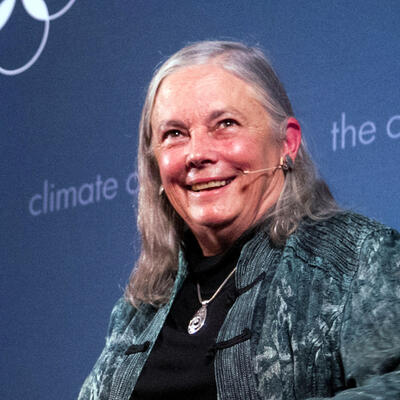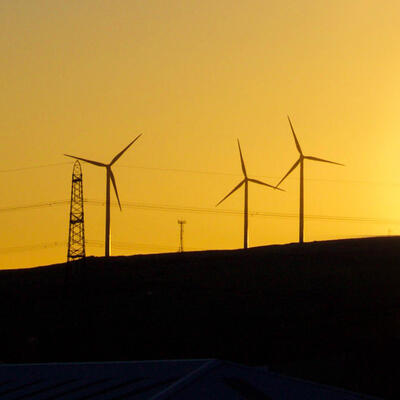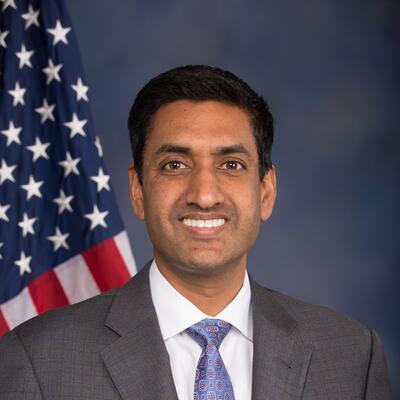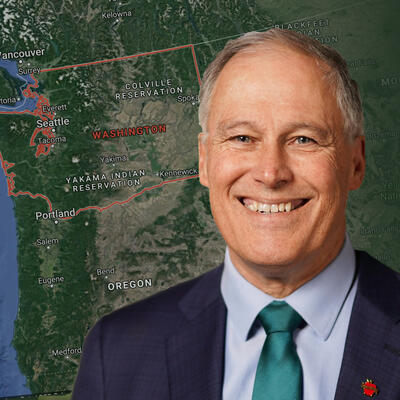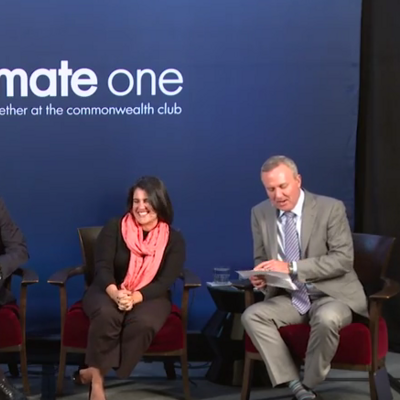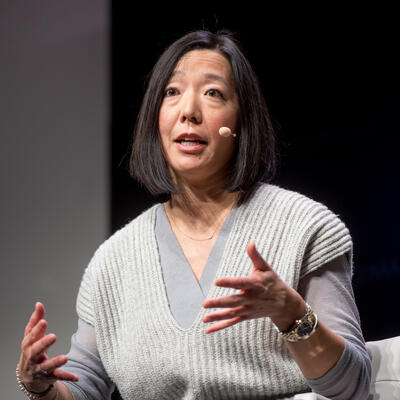
Taking the Temperature of California’s Climate Law
Guests
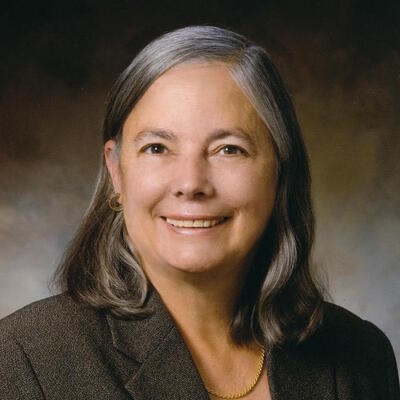
Fran Pavley
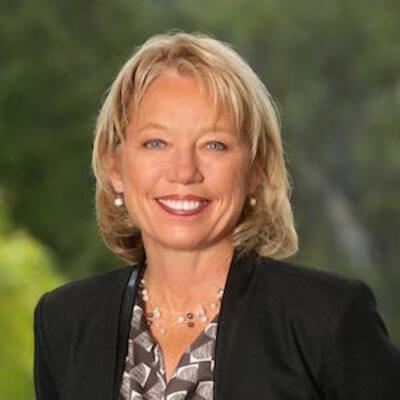
Catherine Reheis-Boyd
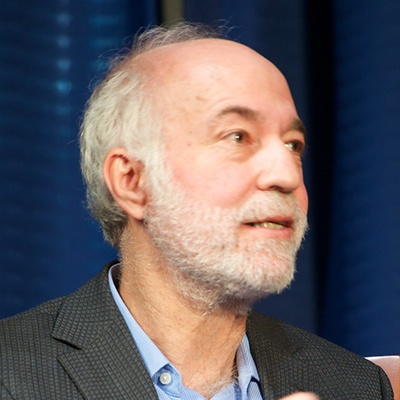
Dan Sperling
Summary
It’s been ten years since California enacted a landmark law that put it at the forefront of the global war on climate change. Has AB 32 been a boon or a bust?
Fran Pavley, Senator, California State Senate
Catherine Reheis-Boyd, President, Western States Petroleum Association
Dan Sperling, Member, California Air Resources Board
This program was recorded in front of a live audience at the Commonwealth Club of California on September 20, 2016.
Full Transcript
Greg Dalton: From the Commonwealth Club of California this is Climate One, leading the conversation about America's energy, economy and environment. I'm Greg Dalton.
It's been 10 years since California Governor Arnold Schwarzenegger launched California's attack on climate change by signing a law to reduce carbon pollution across the state’s economy. That pioneering law known as Assembly Bill 32 or AB 32 is arguably the most important piece of climate legislation in the country. Today, that law puts a price on greenhouse gases and is generating billions of dollars in revenues. It also has put California at the forefront of the global move to protect the climate that supports our economy and lifestyles.
On the show today, we’ll explore the impact of AB 32, and other climate laws are having on the price of gasoline, electricity, jobs, innovation, and our way of life. We also will discuss the prospect of self-driving cars and California's role in the Paris climate agreement, a flexible plan endorsed by nearly every country in the world to move away from fossil fuels.
We’re joined by three people who are playing leading roles in the debate over how California will run its economy and how we all get around. State Senator Fran Pavley co-authored AB 32, and other laws regulating fracking and tailpipe emissions. She recently led the successful effort to extend much of California's main climate law for another 10 years. Now Senator Pavley is in the final weeks of her 16-year career as a state legislator.
Cathy Reheis-Boyd is president of the Western States Petroleum Association, which represents the oil industry in Arizona, California, Nevada, Oregon and Washington. And Dan Sperling is a member of the California Air Resources Board, the main state agency for regulating air quality and carbon pollution. He’s a transportation expert and founding director of the Institute for Transportation Studies at UC Davis. Please welcome them to Climate One.
[Applause]
Welcome you all. I want to go back to 10 years ago this month on Treasure Island and where Governor Schwarzenegger signed AB 32, this California's main climate law. Let's hear what he had to say then.
[Clip]
Arnold Schwarzenegger: It’s great to see all of you here today. And it is wonderful to see so many people be part of this historic occasion. In a few minutes we will be signing Assembly Bill 32. When we sign this we will begin a bold, new era of environmental protection here in California that would change the course of history. In fact, we will create a whole new industry that will pump up our economy.
[Clip End]
Greg Dalton: So Governor Schwarzenegger, Cathy Reheis-Boyd, a new law pump up the economy 10 years later, what’s been the impact?
Catherine Reheis-Boyd: So I mean, the way you’ve actually framed this conversation and I'm really happy to be here Greg with Senator Pavley and Dr. Sperling. We've been actually doing this since 2006 together. So it has been a while of working together on this very important issue. And the way you pose the question is, you know, has it been helpful or hurtful. And frankly I think it's been both.
And I hope we’ll get into that a little bit. But I think on the helpful side I think it really has set a conversation for California that's a very important one, not only in the context of what we can do, but, you know, how that relates to things like the Paris agreement and things that the international community is looking at.
But also as we look at the positive side of it, we also have to find a way to minimize as much as we can the cost of the program. Such that businesses and consumers can still, you know, have the quality of life that they have as we’re trying to move forward. So I sort of have yes on both sides of that question.
Greg Dalton: Done some good, done some bad. Senator Pavley, this is your baby, AB 32. Ten years in, what's the scorecard?
Fran Pavley: Well, as a former teacher, I suppose I would give it an A-. That with a lot more work to be done obviously because this is going to take decades to get this right. Sometimes I look back and I think about what Governor Schwarzenegger said in his, often times in his speeches, he would say, well we don't have to choose between a clean environment and a strong economy. We can have both. And we can look at the math what's happened since AB 32 passed back in 2006. Our economy has gotten bigger and emissions have gone down and we’re on track to meet our 2020 targets. And some of the very popular programs that I know the public's been increasingly aware of and very supportive of our issues such as energy efficiency in buildings and appliances where you save money on utility bill plus reduce greenhouse gas emissions.
We've done tremendous good work on cars, Dan will talk about that. But we're seeing greater fuel efficiency in cars in fact, everyone's benefiting from greater fuel efficiency of cars. And it's now a national policy; it started as a state policy so we’re not going it alone on all these policies. Where by 2026, we’ll average 54.6 miles per gallon, saving people money at the pump and reducing greenhouse gas emissions. So my involvement in all this is making sure to the maximum extent possible we have a win-win-win reducing climate pollution, cleaning up the air because of the contributing factor and health impacts and also creating in-state jobs. And so it's going to take a lot of work by a lot of good people, lot of innovation. So I welcome this conversation as well.
Greg Dalton: Thank you Senator Pavley. Dan Sperling, she gives it an A- has it really helped or hurt the economy or is it a mixed bag as Cathy Reheis-Boyd said?
Dan Sperling: Well, I think there's no, it's so new. So there’s some pieces of it that have been here a little longer like the vehicle standards. But most of it, cap and trade, low carbon fuel standard, they’re just barely getting started. And perhaps the one that's, other one that's had an effect is the renewable portfolio standard requiring renewable energy for the electric utilities. But for the most part, we’re just getting started. And I think the bigger question is we have to do a lot. We have to do something. The science is overwhelming that, you know, climate change is a huge risk to the earth, to California. And the question is, how do we move forward aggressively?
And as Cathy said, we want to do it smart. And as Fran said, there's lots of things low hanging fruit, I mean efficiency like vehicle efficiency. We should have been doing that even if there was no climate change problem, no oil problem. We get somewhat, it cost about to get that 50 miles per gallon. It'll cost us a little over a thousand dollars extra, but we get each consumer, will get back at least $3000 or $4000 extra for themselves. So forget about climate, air pollution everything else. Just on pure economics for the individual it's something really good. And that's the challenge here is to start going down that curve, you know, where are the really good no regrets, high payoff things and figuring out how do we get further.
And I’ll say one more thing, because I have Cathy next to me here. Is that the challenge is that we don't really know exactly what this future is going to be. And some things are going to cost more; we don't know how fast innovation is going to happen. And so we need to be making investments and innovating but we do need some flexibility there. Because none of us are smart enough to know exactly how do we get from here to there.
Greg Dalton: Cathy Reheis-Boyd, let’s talk about there. There is growing in corporate America, growing recognition about climate change. Dan Sperling just mentioned the energy efficiency for automobiles that reduces the demand for gasoline. Is that a good thing, is that something that Western states oil companies support or is that something that you resist?
Catherine Reheis-Boyd: Well, I mean we've always supported energy efficiency and all of its forms. So and we’ve also always supported diversification. I mean it's never good to have all of your eggs in one basket. I mean none of us do that even in our stock portfolios, right. So I do think that it is a time where we have to look at all sources of energy as we go down this path together.
And the one thing that I just get a little concerned about is that, you know, in California the leadership position that it has taken is a very important one. But we have to remember we’re still only less than 1% of the, you know, of the greenhouse gas emissions in the world. So what we do matters from a leadership standpoint, but we have to make sure that we don't take such economic burden on ourselves that all we do is put our state at a competitive disadvantage unless other people are going to follow us.
So it gets really important that whatever signals we’re sending to the rest of the world and whether it, I hope to get into the issue of cap and trade, is because that's really important for the signal to the rest of the world. And we can lead but if, we have to have people follow us because this is a global pollutant, right it does matter where emissions come from and how we address it collectively in the globe. It’s planet issue, it's not in your backyard direct health issue.
Greg Dalton: Sure. California can’t solve the problem. Talk about cap and trade; transportation fuels were included in the program last year. And there was quite a debate about how much that would increase the cost of gasoline. Some large numbers, I think the ultimate credible number is about $.10 a gallon. That gasoline fluctuates by a lot more than that all the time. So is that an acceptable burden or do you think that was too much because some of the numbers that were, the oil industry suggested were a lot larger than that $.10 a gallon.
Catherine Reheis-Boyd: Yeah, and like Dan said, we’re in the infancy of the program, right. So, you know, how much cost will actually be borne by this as the program ramps up, we’ll be, you know, we’ll all be watching, that’s the market, right. Nobody knows what that will be. But when you have not only, first you’ve got the highest taxes on gasoline and diesel, you know, in the U.S. I mean I think we’re the third-highest taxes. Plus now we've got the $.10 for fuels under the cap and trade program.
And you also have another complementary policy as it's called in the state of California the low carbon fuel standard, which also puts another four to five cents on the gallon of gas according to the Energy Commission. So we’re at low crude oil prices so gasoline and diesel are at low cost and so we’re not really feeling that burden. But those are pretty significant cost to the consumers of California and we’re in the infancy of these programs. So I just think cost containment and design factors in the program are really super important so that we control cost while we try to make our climate change objectives. I mean, that’s a balance that has to happen as the program ramps up.
Greg Dalton: Senator Pavley, when this was first envisioned 10 years ago, there were a number of Western states that were going to join California and kind of the ideas that California can’t price itself out otherwise businesses will go to Nevada or Oregon, Utah, lower cost states. A lot of those states rolled off after elections, are no longer standing with California. Isn't it real that there is a risk to California can put itself at an economic disadvantage by pricing energy too high?
Fran Pavley: Well, we always have to be careful and we always look at any kind of leakage that means in simple terms, there's no point in having a carbon polluting industry just move across state lines for whatever reason, because it still affects the planet. But what's really been happening here sort of behind-the-scenes even though what you said was correct, is states are working together. For example, Oregon and Washington and British Columbia joined us with putting in EV infrastructure for electric cars throughout our state.
I just got back a few days ago from Mexico City. Amazing, the National Senate down there just unanimously passed the Paris accord agreement. The president of Mexico, who I met with for an hour, over an hour at the National Palace. He and the president of United States and the Prime Minister of Canada all agreed to adopt California's now the national standard of lower, more fuel-efficient cars. Those will all be used across all three countries. Governor Brown has been very involved; in other states we call them subnational states, provinces, others all adopting similar policies. There's an amazing amount of things going on.
I believe over 40 states now of renewable portfolio standards. We’re waiting on Congress to move forward and in the meantime, the most expensive thing I think we can do as a government is nothing. This is a huge challenge and we’re showing that this can be done cost-effectively and is technologically feasible. And there’s amazing amount of good news stories as well as new technologies that are right on the cusp of moving forward.
Greg Dalton: Blackrock is a large research firm, investment management firm, one of the largest in the world. Catherine Reheis-Boyd, they came out with a report recently that said driverless cars could “trigger a slide in demand for traditional cars and gasoline much quicker than markets expect.” Do you think that EV's and driverless cars; already there’s soft, basically flat demand for gasoline in the United States because of efficiency? What is the potential that the industry's misreading demand and it could fall faster than the market expects enough? And that’s Blackrock talking.
Catherine Reheis-Boyd: Well, I mean, look at California, right? We have, what, 38 million people soon to be 48 million people that drive 26, 27 million cars, 185 billion miles a year. That’s a lot. We’re the third largest gasoline consuming entity in the world as a state and only the two in front of us are China and United States of America. So we travel a lot, we drive a lot, and we use a lot of gasoline and diesel let alone jet fuel and marine fuel.
And then you've got the DOE's, Department of Energy’s energy information administration who looks forward out to say 2040 and they’re still estimating all the energy in the world in 2040, 80% comes from coal, gas and oil. So I think it's just in the context of the conversation we have to sort of have the reality of the facts of what it's going to take and over what time period that we can do these types of transitions. And so, you know, that's a long time and I know we have SB 32 which we’ll talk about now and AB 197 at some point in this conversation which takes us out to other targets on 2030.
But still by 2040 which is 10 years past that, we’re still 80% coal, gas and oil. So it's a transition, right?
Greg Dalton: Dan Sperling, is that true? A lot of environmentalists cheer electric cars, there’s now half a million cars with a plug in the United States, small fraction was a 1% or 2% of new car sales. It's going to take a long time. Is Catherine Reheis-Boyd right that mainly we’re going to be running the economy on fossil fuels in 25 years?
Dan Sperling: Well, that's probably true but I wouldn't agree that as much as, you know, Cathy was quoting some stellar organizations. But I think that there's a lot of rethinking of those numbers and those forecasts. So I do interact a lot with a lot of the big oil companies and DOE and international energy agency and there's a lot of question about whether those forecasts of large continuing amounts of fossil fuel and oil are going to be correct because if you take, you know, vehicle efficiency is actually what's going to make the biggest difference in the next 20 years.
And just look at us we’re going from 27 miles per gallon to 50-some miles per gallon. Our cars are going to be using half as much energy in 2025 as they were in 2010. Now there are more cars that's US. Japan is doing the same thing, Europe is doing the same thing, China, Korea and I guess now Mexico. So this focus on efficiency is happening worldwide. And the question is, are we going to continue on that trajectory. Every new year, the new vehicle is about 4% better than the previous year and you keep doing the 4% and it starts becoming significant.
So U.S., Europe, Japan, everyone agrees we’re going to be using less fuel. The question is, what’s going to happen in China, India, Latin America and whether they're going to and whether we’re going to -- the story I was telling was cars and then we got trucks and planes. So that's kind of the forecast for a lot of fossil energy and a lot of oil, let's say. It’s partly because we’re going to use it for petrochemicals, aviation, probably, you know, although there was an announcement yesterday that JetBlue is going to now use biodiesel for their planes.
So I think it can change -- here's an anecdote in a story, Norway has gone in just a few years from almost 0% electric cars to 35% of their new car sales being electric. Now, ok they subsidize it a lot and there are some explanations but they’ve flipped, you know, they are now in a region where electric cars are normal and gasoline cars are the kind of those dirty, polluting things.
Greg Dalton: Cathy Boyd, Steve Coll wrote a book Private Empire about ExxonMobil. He said the one thing that really could disrupt that business model was a breakthrough in battery technology. Is that true? If there's a big breakthrough in battery technology could that disrupt the oil industry? Do you even worry about electric cars or there are just going to be such a small niche that it’s not going to displace oil?
Catherine Reheis-Boyd: Yeah, I mean, we’re a trade association so we represent all of the companies actually in the five states. And each of them have their own business plan, their own view of the future, and each of them are investing as much as the federal government in research and development on all these alternative and renewable fuels. And each of them have a different look, you know, ExxonMobil may look at lithium batteries while somebody else may buy an ethanol plant to see if they can, you know, make cellulosic, something that can work in the future.
So, I think they're all interested in looking out in their own business plans and figuring out what that means for them as a company. And I can tell you as being a trade association, none of them think alike. They all have different views on the future and it could be solar, it could be wind, it could be battery technology, and Dan knows this probably from talking to my members better than I do. There's a wide range of options they’re looking at as they themselves look at the future and what that means for them as a company.
Greg Dalton: Senator Pavley, Governor Brown recently signed a bill on super pollutants. We’re talking a lot here about carbon pollution which is greenhouse gases. There’s another category of pollutants that are kind of -- a lot of them come out at both ends of the cow. How important is this, this new law to get at dairy and other part methane, other parts of the climate challenge?
Fran Pavley: Well, it fits in really well with segueing into SB 32 because if we’re going to reach the targets they talk about in 2030, the 40% reduction below 1990 levels, all of the above have to be in play, more fuel-efficient cars, electrification of the grid, battery storage technology for cars as well as replacing natural gas for homes or utility power plants. There's actually a new battery storage place that’s opened in the Los Angeles area.
We have an alternative fuel company that was so excited about SB 32 passing, because of the market signal that's being sent that they are investing in new people and they’ve taken over an old oil refinery. They have a long-term contract with United Airlines on biofuels. There's a lot of excitement and moving forward on all these technologies. I know we can do this.
Greg Dalton: Dan Sperling, biofuels were all the rage a few years ago and they haven't really -- they’ve been kind of disappointing actually. Having come through some the companies that started making alternative fuels are now making make up because they can make more money at lower volumes. So, you know, tell us about the prospect for cellulosic biofuels that can go in existing pumps, existing tanks. They’ve been kind of a disappointment.
Dan Sperling: You know, before I answer that let me back up just a second because I want to talk about what California is doing, California's leadership. You know, Fran mentioned that California is not an island and the climate problem is a global problem, but what we're doing in California, so what we do in terms of actual emission reductions in California has a small effect.
But what we do in terms of policy innovation, what we do in terms of creating the industries and the innovation really is global. And we are creating the platform in California for economic growth and leadership by nurturing those technologies, encouraging of it, you know, solar technologies, the batteries, the vehicles, the Teslas. And so, we are positioning ourselves for the future which, you know, is going to be very different and we’re going to be ready for it more than a lot of places.
Now, the biofuel is a big challenge and there are a lot of things that have happened faster than we expected including the battery has improved much faster than any of the experts thought, any of the companies thought. The biofuels has been just the opposite, is that we thought the cellulosic biofuels, the biofuels made out of wood and grasses; we thought we'd have it by now.
The federal government adopted a requirement for, you know, 17, 15 billion gallons of it by 2022. It’s not going to happen. And I think mistakes were made, not enough was invested in developing the right plants that would be used in terms of processing it. There was a lot of hubris that we knew more than we knew and we had some venture capitalists and some others that were overselling it and hyping it.
And so now, I think we’re in a little retrenchment and I think we’re looking at it differently now. Now, we’re looking at, okay we got this big corn ethanol industry and you can think what you want of it but they are bringing some innovation into it. They are getting more efficient, they’re pulling the corn oil out of it to use as a diesel fuel, they’re starting to take some of the corncobs which is cellulose and processing it. So they're making -- it's kind of an incremental path. But I think what we really need now is the oil industry to get engaged.
The oil industry is the only one with the resources, the capabilities to really scale it up to make the investments that are needed because otherwise it's not going to happen fast. It's going to happen slow. And so, I'm just trying to figure out how do we get those oil companies. And some of them are, some of the oil companies that are investing a fair amount as, you know, we’re talking about, you know, Cathy was saying there are some investing in different types of biofuels and advanced biofuels, but it's not very much, and we come back to policy. I don’t know if you want to talk about policy. And that’s what Cathy and I believe.
Greg Dalton: Let’s get Catherine Reheis-Boyd on that. Why aren’t they investing more? They have this sort of this pattern of oil companies, they dip their toe in, they invest, they divest, they don't stay with it very long. Maybe that's because their primary product has higher profit margins than this experiment--
Catherine Reheis-Boyd: No, I mean, frankly if you really look at the data which, you know, the data actually matters, you know, facts actually do matter in these conversations. And if you look at the data the investments that our companies make are equal to the federal government.
And the only next investments by the auto companies are quite far less than the ones we've made. So we are making huge investments to try to figure this out. And it's easier on the diesel side than it is on the gasoline side. On the diesel side, the biodiesel side is progressing pretty well. The difficult stuff on the gasoline side is in California and as you know you can only blend so much ethanol in gasoline before you hit what's called the blend wall.
In California, it doesn't let you blend more than 10% for very good reasons because it begins to have impacts on the engine. So you have 10% to work with that you can blend in gasoline to make it less carbon intensive to lower its carbon. And the only thing we have is either corn-based ethanol or something like sugarcane-based ethanol.
And they’re making progress, but the carbon intensity isn’t where it needs to be to really advance that. And it's just not commercially scalable getting the energy conversion on ethanol side from the biomass to the energy side it's been tough. And not just for our industry, there's been many who’ve tried to, you know, crack that nut. But one other thing I think that's important and Dan began to get into it and I hope we have time here Greg, to touch on it because I am very concerned about where we find ourselves right now relative to the passage of SB 32 and AB 197 which are connected.
And I want to make sure we have that conversation because we have obviously, you know, Senator Pavley here who was very instrumental in having that passed. And my worry is, this program in California from AB 32 has been, cap and trade has been its cornerstone. And why and for the audience who doesn't understand cap and trade, a cap is the environmental side, where is my friend Alex from NRDC, right? It’s a declining cap. It's the environment side of cap and trade. The trade is the business side. It makes it more cost effective to meet that cap, why we like market mechanisms like cap and trade programs or carbon tax that are market-driven.
And now we have cap and trade being the cornerstone of the California program, yet we don't have a program that goes past 2020 on cap and trade. And it seems like when you read AB 197 which is connected to it, that we’re transitioning away from cap and trade and we seem to be moving more back to command-and-control. And I may be reading it wrong, I haven't dug into it entirely yet but I get concerned and I see the report just released by the California Environmental Justice Alliance which basically says cap and trade should go away. And so I find myself sitting here wondering how are we going to reconcile that with our leadership position in Paris and the rest of the international community going to cap and trade and us sort of figuring out where we are going.
Greg Dalton: So let me just clarify it. You're saying cap and trade should stay and you’re supporting it and yet there is a California Chamber of Commerce lawsuit that’s trying to challenge cap and trade.
Catherine Reheis-Boyd: So let's be clear on that because again, facts matter. And so if you look at the Attorney General's brief on the Chamber of Commerce's litigation, it actually says on page 2 that it is not in any way an attack on climate change. The only thing the Chamber’s lawsuit says is that did AB 32 authorize the auctioning of revenues to generate billions of dollars and is that a tax or a fee, and if it was a tax it should've been a two-thirds vote. That’s it.
Greg Dalton: Senator Pavley, the future of California's climate program we’re hearing that from Catherine Reheis-Boyd from the oil industry that she has some challenges. What is your response to that?
Fran Pavley: My response is the cornerstone for AB 32 was the cap, the cap on emissions.
Greg Dalton: The environmental benefits to fight climate change.
Fran Pavley: Right. Now historically, whether it's combating smog, right, and cars, it was the command-and-control and reduction of the emissions. Business community wanted some flexible compliance mechanisms in reducing emissions. (0:36:07)
They can either make direct reductions so their refineries or whatever carbon they were emitting could be continued to go on but reduce their emissions to comply or they could purchase allowances that would allow them to pollute; we always say, they would have to pay to pollute. So the discussion we’re having and it gets to be hanging on very much insider’s game, I guess, is do you want to in future years pass cap and trade post 2020?
There’s some legal debate on whether you needed two-thirds vote or not. I would say to you, most of the business communities now that SB 32 is passed and there’s a cap on emissions going to 2040, they will want the flexible compliance mechanisms and that it may require a two-thirds vote. So part of the discussions in cap and trade is where the money is being expended and most of the benefits would probably go to a lot of the disadvantaged communities who bear a disproportionate share to the impacts in climate change; that gets a lot of people in the room as well. So I would say that'll be one of the discussions in the next two years for Governor Brown in the next legislature.
Greg Dalton: We’re talking about California's climate action plan at Climate One. That’s State Senator Fran Pavley. We also have Cathy Reheis-Boyd, from the Western States Petroleum Association and Dan Sperling, a member of the California Air Board. I’m Greg Dalton.
We’re going to go to our lightning round and ask a series of yes or no, quick association questions of our guests. So yes or no, Dan Sperling, electric vehicles will save the bacon of electric utilities otherwise caught in a death spiral?
Dan Sperling: No. They will be successful, but they would not for the --
Greg Dalton: They won’t save the utilities. Cathy Reheis-Boyd, you are happy Senator Pavley is termed out of office?
[Laughter]
Catherine Reheis-Boyd: No. No.
Fran Pavley: I have to say I always offered the oil companies an option; they could have bought out my contract, I’ll live in Hawaii --
[Laughter]
No. So SB 32, see what happens.
Dan Sperling: You can say anything you want now.
Fran Pavley: Isn’t that nice? I’m just kidding.
Catherine Reheis-Boyd: Yeah, of course.
Fran Pavley: I’ve actually enjoyed the relationship but, you know, as former senator Sheila Kuehl always told me, you can always be gracious when you win.
[Laughter]
Greg Dalton: Fran Pavley, oil companies extract fuel from the age of dinosaurs and if they don't adapt quickly some of them may become dinosaurs themselves?
Fran Pavley: True.
Greg Dalton: Cathy Reheis-Boyd, Tesla’s gigafactory for car batteries gives you heartburn?
Greg Dalton: Cathy Reheis-Boyd, yes or no, white people in California breathe cleaner air near their homes than people of color?
Catherine Reheis-Boyd: Could be true.
Greg Dalton: Dan Sperling, when it comes to fighting public interest in cleaner fuels, Chevron is the new Exxon?
Dan Sperling: Well that implies a lot of things. They have not, Chevron has not been supportive of biofuels.
Greg Dalton: We are going to change this a little bit and just I want to mention a word or phrase and you tell me what first pops into your mind. No filtering.
Catherine Reheis-Boyd: This is kind of fun.
[Laughter]
Greg Dalton: Cathy Reheis-Boyd, the new Chevy Bolt the BEV with a 200-mile range and a $35,000 price tag.
Catherine Reheis-Boyd: What am I supposed to say, what pops in my mind?
Greg Dalton: Yeah, what do you think about the Chevy Bolt?
Catherine Reheis-Boyd: Interesting.
Greg Dalton: Fran Pavley, hamburgers.
Fran Pavley: Less beef.
Greg Dalton: Dan Sperling, high-speed rail.
Dan Sperling: Hopeful solution.
Greg Dalton: Cathy Reheis-Boyd, Volkswagen diesels.
Catherine Reheis-Boyd: Like them.
Greg Dalton: Governor Jerry Brown, for Cathy Reheis-Boyd.
Catherine Reheis-Boyd: Pragmatic
Greg Dalton: Also last one for Cathy, not last one, another one for Cathy. Cathy, California's new law regulating cow burps and other certain super pollutants.
Catherine Reheis-Boyd: Tough.
Greg Dalton: Dan Sperling, the American Petroleum Institute.
Dan Sperling: Slowing things down.
Greg Dalton: Also for Dan Sperling. Fran Pavley’s legislative legacy.
Dan Sperling: Brilliant and long-lasting.
Greg Dalton: Fran Pavley, fracking.
Fran Pavley: You got it I think.
Greg Dalton: You wrote the law regulating, it’s on --
Fran Pavley: I know, I had to work with the oil companies. And we did it but it’s regulated. We know where they’re fracking, what water they’re using. They better not be contaminating aquifers and eventually it'll be phased out.
Greg Dalton: Also Fran Pavley, retirement.
Fran Pavley: Looking forward.
[Laughter]
Greg Dalton: And the last one for Cathy Reheis-Boyd. The Republican Party.
Catherine Reheis-Boyd: In transition.
[Laughter]
Greg Dalton: Alright, that’s the end. How they do? Let’s give them a round for getting through that.
[Applause]
[CLIMATE ONE MINUTE]
Announcer: A big part of meeting our state’s emission reduction goals is getting Californians to give up the gas-hoggers. In 2011, Anthony Eggert of the California Energy Commission envisioned us having a million EV’s on the road by 2020. So, how are we doing on that? Eileen Tutt of the California Electric Transportation Commission joined us recently with an update – and some good reasons to make the switch.
Eileen Tutt: We have about 160,000 vehicles and so we have four more years to do 840,000 vehicles. I believe we can make it to a million, but I think the challenge right now is all about gas prices. The fact that you can get gas at two dollars a gallon is really, really hurting this market. And I don't see that changing anytime soon but I guess I'm still hopeful that we’ll get close to a million. I think it's great to have that good target. And I want to point out that I think what we’re doing in California, the zero emission vehicle requirement from the Air Resources Board is very important, but we also have incentive programs.
The federal government offers very generous incentives. There's something called the low carbon fuel standard where your utility will give you money on your utility bill if you tell them you have an electric vehicle and you plug it in at home. There are HOV lanes in California. So in this state the mandate or the requirement on automakers is one component but I think part of the reason we’re succeeding this time where we didn't succeed last time, is because the state government in all, you know, at the Public Utilities Commission, at the California Energy Commission, at the Air Resources Board and now the Federal Government. Everybody's pulling together to try to encourage consumers to make, you know, the greenest choice out there which is a plug-in electric vehicle.
Announcer: That’s Eileen Tutt of the California Electric Transportation Commission, speaking to Climate One in 2016. Now, back to Greg Dalton and his guests at the Commonwealth Club.
[END CLIMATE ONE MINUTE]
Greg Dalton: We are talking about climate change at Climate One with our guests Cathy Reheis-Boyd from the Western States Petroleum Association. State Senator Fran Pavley and Dan Sperling a transportation expert.
Dan Sperling, tell us about Paris, you said earlier that California's leadership was significant. So Paris is this big deal, all the countries are on board for doing it. How does California matter there as Cathy Reheis-Boyd said earlier we’re only 1% of the problem?
Catherine Reheis-Boyd: Less than.
Dan Sperling: I was hoping you were doing part of the previous. I was going to say great wine, cheese.
[Laughter]
Greg Dalton: Oh, Paris. Yeah, yeah.
Dan Sperling: More serious so. Well, I think California has played a huge role in one as a leader and influencing and watching what happens in Washington, never mind elsewhere. You know, like I personally, I worked with China on their development of a zero emission vehicle mandate for China.
So we from California are having a lot of influence around the world and we give, I mean, for a long time United States was kind of a laggard in addressing climate change, and I think now, you know, thanks in large part to California's role it's no longer seen that way. In California, you know, when Governor Schwarzenegger and Governor Brown they go around the world and they speak and they encourage the sub nationals and they’re having a big influence.
And Paris represents the nations of the world joining together and saying we've got a big problem. We've got to do something about it. And we used to hear all these stories about well, we’ll be disadvantaged relative to China, but everyone's on board. China, you know, is investing more in renewable energy and is investing more in electric vehicles than we are. So, I mean, I don't buy the argument anymore that, you know, worrying about being disadvantaged. There are so many parts of the world that are moving forward aggressively, more aggressively than we are.
Greg Dalton: And one area that is pushing that is this increasing well, concern about the carbon budget, there’s a certain amount of carbon that we can burn to stay below with a redline the world community has drawn. We are already more than halfway there I think. At current rates we burn through that whole budget in about 10 years. Early last year we had Angus Gillespie, vice president for CO2 at Shell Oil here at Climate One for a discussion on the future of oil. He had a very interesting point to make on what has been described as a carbon bubble. Let's listen to Angus Gillespie from Shell Oil.
[Clip]
Angus Gillespie: So you’ve heard a lot of talk recently about things like unburnable carbon, the carbon bubble and other things. This is the market the investors are starting to realize how significant a risk climate change can be to their investment stalk. Now, this is a type of thing that starts to get real action because once senior executives see the impact on the stock price then you know real activity, long-term activity really starts to take traction.
[Clip End]
Greg Dalton: That’s Angus Gillespie from Shell Oil. Catherine Reheis-Boyd, that's an oil executive saying that they’re concerned about this 30-year investments they’re making that they may not get their money back; they have to write down those investments if there is a price on carbon or -- the economics are changing.
Catherine Reheis-Boyd: And I think one of the things that I'm very interested in hearing about from Senator Pavley and Dr. Sperling is this issue of how do you price carbon. I’m in an interesting position with my companies that I represent that have different views on market mechanisms and as you know we have two. We have a cap and trade program which is a market mechanism and we have a carbon tax which is a market mechanism. And for the audience the only difference is, is in cap and trade you certainly know the emission reductions you’re going to make but you are not as certain about the price.
On carbon tax, you know the price but you’re not as certain on the reductions you make, but they're both driven by the market. And I'm very curious where the conversation is going to go on cap and trade versus a carbon tax because you’re looking up in Washington State. I mean, we have an initiative of 7-32 on the ballot right now that is a carbon tax. So you’ve got all these different things sort of swirling around on what is the right answer. I know the Air Resources Board certainly looked at a carbon tax early on. So I’m just sort of curious if I could just get their views on that versus cap and trade. I’m just fascinated by trying to figure it out.
Greg Dalton: Senator Pavley, California has chosen cap and trade. Secretary Shultz and some Republicans support a carbon tax. There are some rumors that a carbon fee may be introduced to the new Congress next year 2017 by Republicans. Your take on how that would affect California.
Fran Pavley: It's been a fascinating discussion and I think we all agree you have to put a price on carbon and that's what we’re doing whether it's cap and trade. Here's where I have an issue with the carbon tax. It really is not a very progressive tax; it really disadvantages, you know, lower income people. It does send a price signal. But let's look at this.
Right now, if oil companies are polluting, they’re buying allowances and we’re using it to reduce greenhouse gas emissions that we can quantify those reductions. A carbon tax, they're not paying a thing. You're paying it at the pump when you refill your car. It's the public that's paying it. So when we had this discussion a few years ago, Darrell Steinberg had authored a bill that was supported by the oil companies, they want to shift it over there.
So it does have a price signal. Some people prefer that. I think national policy we should all get behind whichever direction that they so choose. But you need a combination of incentives and investments in order to reduce carbon emissions. I'm not sure carbon tax by itself is going to get the job done because of the cost shifting it's going to go to. It's not going to the polluter per se unless there’s a way to do that. It's going to the end-user.
Greg Dalton: Dan Sperling, it’s pretty messy. There are different states tackling this differently. We don't have national action. You know, how can this be effective?
Dan Sperling: Okay. I need to speak as a professor here. I did my diplomatic answers already. I mean, okay, one big issue here is how do you use the money because with the carbon tax you generate lots of money too. I mean, you generate essentially the same amount of money depending on how you do it whether it's cap and trade and carbon tax. And one question is how do you use that money.
And, you know, I think to get it accepted on a national level it's going to have to mostly go back through income taxes or rebates. And you can structure it so that lower income people get more of it. And that probably should happen; you should probably take a certain percentage of it, and dedicate it to those that are most disadvantaged. You should probably take some of it to companies that are disadvantaged in some way. You probably should put a little in R&D, but probably I mean most economists now would say you should give it back in some way, that's the most efficient thing to do.
So the problem, so the thing with carbon tax, so one, I used to be a much stronger advocate for cap and trade relative to carbon tax but one of the things I’ve come to understand is with a carbon tax something Cathy said, I think is right is that it sets a specific certain price on carbon. And I always thought, yeah, okay, but company after company comes to me, biofuel companies all kinds of low-carbon efficiency, innovation, efficiency companies say I need to know what the price will be so I can go to the bank, you know, low carbon fuel standard is another one.
I need it when I go to the bank I got to be able say, I’m going to get that much, you know, bonus from having a price on carbon. It's one of the weaknesses of the cap and trade. On the other hand, cap and trade really provides a structure with a certain amount of certainty, it makes it easier to connect with other geographic regions, you know, at the end of the day there’s no good answer on this I think.
Greg Dalton: We’re going to go to audience questions. We’re talking about climate change at Climate One. Welcome.
Female Participant: Hi, my name is Sarah Golden. I run an online social media campaign called Stop Fooling California. My question is for Catherine Reheis-Boyd. I'm wondering if in some ways when you look at the past and what’s happened in energy and climate policies. If you in some ways, have blind spots of what's going to happen in the future and how much you're, the way that you represent different industry interests may shape the way that you may not be forward-looking.
Catherine Reheis-Boyd: Well, thank you for that question. And obviously I know your organization well. I hope not. I mean, I really hope I don't. And I hope our industry doesn't. And I think we have evidence of that. I mean we've been engaged in these conversations since 2006. I mean we were supportive of the bill in 2015, which was to actually extend cap and trade past 2020. That was our organization. That was the Atkins Bill AB 1288. Now we certainly had things we wanted to make sure happened if that was the case.
And again we didn't as an industry, you know, we don't even have a position on whether we prefer cap and trade or carbon tax of both market mechanisms. And I have companies who like one versus the other all over the place. So we do support having a market mechanism but not necessarily which one of those the state may choose. As Dan said it kind of makes the same approach.
And so the only things we were concerned about if California picked a cap and trade program, which we did, was to make sure that the businesses and consumers are as protected as possible because the costs are high and we still have a state that’s very diverse. We have still a high poverty rate. We still have people that are very much unemployed and above the national average.
So we have to look at these choices going forward as I think we have, both from the environmental side and the economic side. And I am a firm believer that the two go hand in glove and that you can have both. But the design factors are really, really important on what we do here not only in the past, but certainly now going forward.
Greg Dalton: Economist Nick Stern who was sitting up here a couple months ago would also say there's a cost to doing nothing. That climate change can shave 10% to 20% off of global GDP. So would you recognize Cathy that there is a cost of inaction also?
Catherine Reheis-Boyd: Absolutely. In fact there is three really there, I mentioned two. I mean it’s really social, environmental and economic, right. It's all three of those that are very, very important. And how we deal with communities is extremely important. And in the space of climate change I'm hoping that we can understand that at least for communities dealing with pollutants that are impacting people's health is through a program that's designed in the criteria pollutants side.
It's with particulate matter and sulfur dioxide and nitrogen dioxide that is a direct impact to health. That is not a climate change problem. That's a criteria pollutant problem. When we’re in climate change, we’re talking about a global pollutant that we cannot just be the only state that incurs huge cost because energy costs are high, electricity is high. I mean, and we have a very diverse population. So it's not an easy answer, right. We've got to come together on all three of those social, economic and environmental policies.
Greg Dalton: Let’s go to our next question. Welcome to Climate One.
Male Participant: Yes, Jeff Ricker. Fran and Dan, has anyone quantified the benefits of these laws here in terms of how much lower the world's temperature is from all this?
Greg Dalton: Dan Sperling, how can you measure California's leadership quantified?
Dan Sperling: Well, we haven't gotten much reduction as I said in the beginning we’re really just getting started. So the amount of reduction, I mean, you know, you could twist that question into all kinds of things. But I think at the end of the day, you can't think today, tomorrow, one year. This is the future of the planet the future of the human race, the future of species.
So we know we need major reductions. I think a much better way of thinking about it is, you know, what do we do that's most cost-effective as soon as possible, but also there are some things we have to position ourselves for the long term as well. It might cost a little bit more in, you know, in the near-term. So it's really certainly we need to be using cost as a metric and analyzing what we do, but there's a lot of uncertainty and both on the cost side in terms of forecasting costs, you know, that's my profession.
And I hang out with people that were forecasting what's the rate of innovation, what’s going to happen the cost of batteries, what's going to happen to all these new technologies that we’re talking about. But then there's uncertainty there, there's even more uncertainty on the impact side to know how bad are we destroying the world, fires and rising waters. So yes, I could give you a quantitative number but it wouldn't be very meaningful because we need to, you have to think about it as a supply curve of options.
And let's start doing the cheapest things and preparing for long-term and then we'll figure out the price of carbon. I mean people say it should be valued at $50. We are not pricing. So most people say we should price at $50 a ton. Our cap and trade program is $12 a ton. So clearly we’re not doing a good enough job in California and elsewhere in terms of pricing carbon in a way that leads us to the best, most cost-effective reduction in carbon. (01:00:01)
Catherine Reheis-Boyd: Greg, can I add to that?
Greg Dalton: Sure, Cathy, go ahead.
Catherine Reheis-Boyd: Oh sorry. Want to go first senator?
Fran Pavley: Well I just, we've had sort of those kinds of questions thrown at us before sort of that gotcha kind of thing. So I wanted to talk about is really sort of success story. And I was in the legislature back in 2002 or ‘03. The most controversial bill back then was to come up with renewable portfolio standard. All the utilities opposed, Chamber of Commerce opposed and this was for 20%, it was the Senator S bill, 20% of all our energy make sure come from clean renewable sources. We just come through a horrible deregulation where economy had really tanked, brownouts everywhere if you remember. We’re in such a better place today. We have diversified our energy supply.
So fast-forward, several years after the 20% showing that we could do that and the utility companies got behind it because they realized it was really a smart investment in renewable energy for them to diversify their portfolio. Then it came to 33% we’ve getting bipartisan support in the legislature because wind and solar companies are in everyone's district. And now the utility companies at the plate ended up supporting 50% of all the energy mix in the state of California will come from clean renewable sources; in state jobs no more Enron gaming the system here that's been a tremendous benefit to the state of California and its economy and the concern at the beginning was the price of photovoltaic cells.
It's cost effective, we have financing plans like the SolarCity no upfront costs and the list goes on and on. So these embedded policies in what is called AB 32 or SB 32 are the real success stories where they’ve saved people money and also help the environment, but creating jobs at the same time. And so those are the kinds of cost effective, technologically feasible conditions with those market signals for investment in our state that have become really beneficial.
Greg Dalton: Let’s have Cathy quickly and then we’ll go to our next question.
Catherine Reheis-Boyd: Yeah, the one thing that the gentleman brought up that just spurred a thought and that is with SB 32 and AB 32 you really are talking about problem with like 55% reduction or I think it’s about 15% into AB 32, another 40% projected under the new bill. That's 55% reduction in emissions from a state that's less than 1% of the problem. And so I just, I don't say that in a negative way.
I just say it in a way that we should condition our leadership such that we challenge other people to join in the fight on climate change, because if we don't and that’s why you hear economists talk about conditioning California's policy like we’ll do it if you do. To challenge them to join because if not, the cost of 55% reductions in this short of a time period when it’s less than 1% of the climate’s problem, that’s a hefty price tag. And so it just reminded me that --
Greg Dalton: I've gone to several of the UN climate conferences. The one in Mexico particularly was after the collapse in Copenhagen. And people look to California leadership, without California leadership the U.S. is not as credible. They look to California for leadership on culture and innovation, lots of things. So that leadership matters it makes the U.S. more credible in those international arenas. Let’s go to our next question.
Greg Dalton: Next question. Welcome to Climate One. We’re talking about climate change.
Male Participant: Hi, Ryan Shoehart with Calstart. Senator Fran Pavley, thank you for your many years of brilliant leadership. I have a question for anyone who’ll take it. One year ago we got SB 350, which directed CPUC to direct utilities to accelerate widespread transportation electrification. Last week the CPUC did so and utilities are now working on that. What does widespread transportation electrification look like? What will we see when it's here?
Greg Dalton: Who’d like to tackle that? Dan Sperling, car guy.
Dan Sperling: My favorite topic.
Catherine Reheis-Boyd: He’s writing a book.
Dan Sperling: Yeah, I’ve written many books about that. So electrification is -- for light duty vehicles, it’s going to be almost total electrification. It's really just a question of how soon and exactly the nature of it. So I drive a hydrogen car which is an electric car. And I get hydrogen, but it's an electric car. So we’re going to have some mix of battery electrics, plug-in hybrids and fuel-cell electrics, light duty. The heavy-duty, the trucks is a lot more problematic. It's more challenging.
It's going to be some mix of electric battery electrics for shorter vehicles making short trips and biofuels and hydrogen. But I think it's pretty clear that we’re going to light duty, we are definitely electric. You can talk to any car company, not a single one of the major car companies would argue with that anymore. It's a done deal and it's really just a question of how fast do we do that. And so that means, you know, more chargers, you know, fast chargers, hydrogen stations out there.
Catherine Reheis-Boyd: The gap is pretty large. Obviously the time period here matters because it’s about 3% of the market right now in California. We have about 200,000 electric vehicles and 26 million other kinds of engines. So that's a pretty big gap between the two. So I think the timing issue that Dan brings up is a really important one. And let's not forget natural gas, I mean it has been probably the single most, you know, biggest thing we've done in the United States to deal with climate change is our ability to produce natural gas.
Greg Dalton: Let’s end it there. Our thanks to State Senator Fran Pavley, Cathy Reheis-Boyd with the Western States Petroleum Association and Dan Sperling. I’m Greg Dalton. Thank you all for coming and listening.
